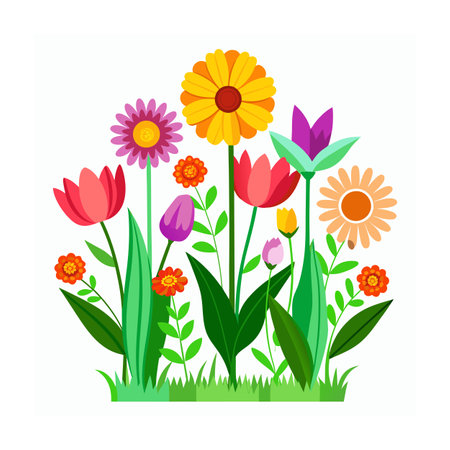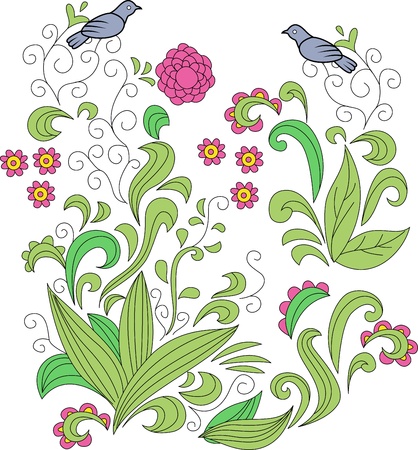Introduction to Four-Season Flower Gardens
Imagine stepping into your yard and seeing vibrant colors and lively blooms, no matter the season. That’s the magic of a four-season flower garden—a landscape that transforms throughout the year, offering changing color themes and constant visual interest. In the United States, where climate zones range from frosty winters in the North to long, warm seasons in the South, designing a garden for year-round beauty is both practical and rewarding.
Four-season gardening means planning your flower beds so something is always blooming or adding texture, whether it’s spring tulips, summer coneflowers, autumn mums, or winterberry holly. This approach keeps your home landscape lively and inviting all year long. Plus, it can increase curb appeal, provide habitats for pollinators, and create spaces for you to enjoy outside with family and friends.
Why Embrace Four-Season Gardening?
- Continuous Color: By mixing early bloomers with late-season stars, your garden never looks dull or bare.
- Seasonal Interest: Flowers aren’t the only showstoppers—think about berries, seed heads, evergreens, and ornamental grasses for winter interest.
- Wildlife Friendly: Year-round plantings support birds, bees, and butterflies through every season.
Seasonal Color Themes at a Glance
| Season | Main Flower Types | Color Palette | Key Features |
|---|---|---|---|
| Spring | Tulips, Daffodils, Hyacinths | Pinks, Yellows, Pastels | Fresh blooms after winter; bright new growth |
| Summer | Daylilies, Coneflowers, Black-eyed Susans | Bolds (Red, Orange), Purples | Full blooms; lush foliage; vibrant borders |
| Fall | Mums, Asters, Sedum | Burgundy, Golds, Deep Oranges | Rich colors; late blooms; textured seed heads |
| Winter | Holly, Witch Hazel, Ornamental Grasses | Evergreen tones, Reds (berries), Bronze grasses | Berries; interesting bark; evergreen structure |
The Benefits of Dynamic Color Year-Round
A thoughtfully designed four-season flower garden creates excitement as the scenery shifts with each season. It makes your home landscape feel alive and ever-changing—something neighbors will notice and you’ll enjoy every time you step outside. Whether you live in New England or California, with some planning and plant know-how, you can enjoy a beautiful garden that celebrates every season.
2. Spring Awakening: Fresh Beginnings
Spring is the season when gardens burst into life, and American yards become a canvas for vibrant colors and new growth. As winter fades, classic spring blooms like tulips, daffodils, and hyacinths take center stage. These beloved flowers not only signal warmer days ahead but also set the mood for the entire gardening year.
Classic Spring Blooms for American Gardens
| Flower | Bloom Time | Popular Colors | Best For |
|---|---|---|---|
| Tulip | March – May | Red, pink, yellow, purple, white | Borders, mass plantings |
| Daffodil (Narcissus) | March – April | Yellow, white, orange | Naturalizing lawns, under trees |
| Hyacinth | March – April | Purple, blue, pink, white | Pathway edges, containers |
| Crocus | February – March | Purple, yellow, white | Lawn accents, rock gardens |
| Forsythia (Shrub) | March – April | Bright yellow | Hedges, early color spots |
Trending Spring Color Palettes in the U.S.
This year’s trending palettes blend classic pastels with bold modern hues for a fresh look that reflects American tastes. Here are some favorite combinations:
- Pale Pink & Soft Yellow: Gentle and optimistic—try pairing tulips with daffodils.
- Lilac & Sky Blue: A calming combo—mix hyacinths and grape hyacinths for cool elegance.
- Citrus Burst: Add pops of orange and tangerine with tulips or ranunculus for energetic flair.
- Crisp White & Green: Simple and clean—white narcissus mixed with ferns or hostas channel freshness.
- Purple Punch: Combine crocus, iris reticulata, and alliums for bold late-spring color.
Tips for Harmonious Spring Garden Design
- Layer Heights: Plant taller blooms like tulips behind shorter crocuses or groundcovers to create depth.
- Select Bloom Times: Mix early and late spring flowers so your garden evolves over several weeks.
- Add Evergreens: Use boxwoods or dwarf conifers as structure so colors pop even more against green backdrops.
- Create Drifts: Group the same flower in clusters rather than single rows for a more natural look.
- Mingle Annuals & Perennials: Fill gaps with pansies or violas while waiting for perennials to mature.
A Spring Garden That Captures Renewal
The secret to a magical spring garden is embracing both time-honored favorites and fresh trends. By blending these elements thoughtfully, you’ll celebrate the spirit of renewal that defines this special season across American landscapes.

3. Summer Vibes: Bold and Bright Displays
When summer arrives, gardens across the United States burst into vibrant life. This is the season for bold colors, big blooms, and lots of sunshine. To create a show-stopping summer flower garden, focus on sun-loving, heat-tolerant flowers that thrive in the American climate.
Top Summer Flowers for U.S. Gardens
| Flower Name | Color Options | Special Features |
|---|---|---|
| Sunflower | Yellow, Orange, Red | Tall, attracts pollinators, classic summer vibe |
| Zinnia | Red, Pink, Orange, White, Purple | Drought-tolerant, continuous blooms |
| Black-Eyed Susan (Rudbeckia) | Yellow with dark center | Tough, native to North America, long-lasting color |
| Coneflower (Echinacea) | Purple, Pink, White | Pest-resistant, attracts butterflies |
| Lantana | Multi-color clusters (red, orange, yellow) | Great for containers and borders; drought-resistant |
| Marigold | Gold, Orange, Yellow | Naturally repels pests; thrives in heat |
| Canna Lily | Red, Orange, Yellow, Pink | Tropical look; dramatic foliage and blooms |
| Salvia | Purple, Blue, Red, White | Attracts hummingbirds; long blooming period |
Strategies for Maximum Impact During Summer
Create Colorful Groupings
Plant flowers in large drifts or clusters instead of single rows. Grouping three or more of the same plant together makes colors pop and helps fill out your garden bed quickly.
Add Height and Layers
Use taller plants like sunflowers and cannas at the back or center of beds. Layer shorter plants such as zinnias and marigolds in front. This creates depth and a lush look from every angle.
Select Repeat Bloomers and Deadhead Regularly
Choose varieties known for continuous flowering throughout the season. Remove faded blooms (deadheading) to encourage even more flowers to appear all summer long.
Mix in Foliage Plants for Texture Contrast
Bright flowers look even better when paired with interesting foliage. Consider adding ornamental grasses or plants like coleus to add texture and break up blocks of color.
Pro Tip: Water Wisely!
Water deeply but less frequently to encourage strong roots. Early morning watering is best—this reduces evaporation and helps keep your summer blooms looking their brightest during hot afternoons.
Summer Garden Design Inspiration Across America
No matter if you’re gardening in Texas heat or enjoying cooler Pacific Northwest summers, there’s a bold combination waiting for you. Mix annuals with perennials for reliable color every year. Try pairing sunny yellow black-eyed Susans with purple coneflowers for an all-American look or cluster fiery red lantanas with gold marigolds for a Southern-inspired border bursting with energy.
4. Autumn Richness: Warm Tones and Texture
As summer fades and the days grow shorter, your four-season flower garden can truly shine with the warmth and texture of autumn. American fall gardens are famous for their cozy color palette—think rich golds, fiery reds, deep oranges, and earthy browns. Here’s how to create that iconic look with perennials, ornamental grasses, and foliage that keep the color going until winter.
Bring on Bold Perennials
Fall-blooming perennials are a must for late-season color. Favorites like asters, chrysanthemums (mums), sedum ‘Autumn Joy,’ and goldenrod light up the garden when most summer flowers have faded. Plant these in clusters or drifts for a bold impact. They’re also pollinator magnets, supporting bees and butterflies as they prepare for winter.
Add Drama with Ornamental Grasses
No autumn garden is complete without ornamental grasses. Their feathery plumes sway in the breeze and catch the golden sunlight, adding movement and softness to your beds. Try varieties like switchgrass, little bluestem, or fountain grass for classic American prairie style. Many grasses develop reddish or bronze tones as temperatures drop, perfectly blending with fall colors.
Foliage That Steals the Show
Don’t forget about foliage! Shrubs and perennials with colorful leaves bring another layer of interest. Plants like burning bush, oakleaf hydrangea, sumac, and Japanese maple offer brilliant displays as their leaves shift from green to scarlet or amber.
Top Picks for Autumn Color
| Plant Type | Recommended Varieties | Main Colors |
|---|---|---|
| Perennials | Asters, Mums, Sedum ‘Autumn Joy’, Goldenrod | Purple, Yellow, Pink, Gold |
| Ornamental Grasses | Switchgrass, Fountain Grass, Little Bluestem | Burgundy, Bronze, Tan |
| Foliage Plants | Burning Bush, Oakleaf Hydrangea, Sumac | Red, Orange, Deep Purple |
Tips for an Iconic American Fall Garden:
- Mix different plant heights for a natural look—tall grasses in the back, mid-sized perennials in the middle, and low-growing groundcovers up front.
- Add pumpkins or decorative gourds among your plantings for a festive touch.
- Use mulch made from shredded leaves to enhance soil health and complement fall colors.
- Let some seed heads remain for birds to enjoy during colder months.
- Choose native plants whenever possible—they’re better suited to local climates and support wildlife.
The result is a garden that glows with warmth and texture right through Thanksgiving—just like those classic American landscapes we all love.
5. Winter Interest: Structure and Subtle Hues
Winter doesn’t have to mean a dull, colorless garden. With the right choices, your flower garden can show off beauty and interest even when temperatures drop and snow covers the ground. Here’s how you can keep your American garden lively during the coldest months:
Evergreens: The Backbone of Winter Gardens
Evergreens are essential for four-season gardens. They hold onto their leaves or needles year-round, providing green structure when most other plants are bare. In the U.S., some great options include:
| Type | Popular Varieties | Best For |
|---|---|---|
| Shrubs | Boxwood, Holly, Mountain Laurel | Foundation plantings, hedges, accent pieces |
| Trees | Pine, Spruce, Arborvitae | Windbreaks, privacy screens, vertical accents |
| Groundcovers | Juniper, Creeping Thyme, Vinca Minor | Low borders, erosion control, filling gaps |
Winter-Blooming Plants: Pops of Color in the Cold
Certain plants bloom or show colorful berries in winter. These give your garden cheerful touches and help feed birds. Some favorites for American gardens are:
- Witch Hazel: Yellow or orange flowers appear on bare branches in late winter.
- Hellebores (Lenten Rose): Blooms in shades of pink, purple, white—even through snow.
- Winterberry Holly: Female plants produce bright red berries that last into winter.
- Camas Lily: Blooms early in milder winter climates along the West Coast.
The Power of Hardscape Elements
When flowers fade and perennials die back, hardscaping becomes even more important for visual interest. Consider adding:
- Stone paths or patios: Natural stone stands out against snow and looks beautiful year-round.
- Decorative fences or arbors: Painted wood or metal adds style even without leaves or blooms.
- Boulder groupings: Rocks provide texture and frame plantings all year long.
- Garden sculptures or birdbaths: Add personality and attract wildlife in every season.
Tying It All Together: A Four-Season Approach
If you want a flower garden that shines in every season—even winter—start by mixing evergreens with a few winter-bloomers and thoughtful hardscape features. Layer these elements for a landscape that offers depth, color, and structure no matter what the weather brings. With these choices, your American garden will feel alive and welcoming all year long—even on the chilliest days!


